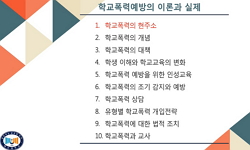Advances in omics and immunology over the past 20 years have revolutionized the approach to cancer prevention, with the goal now focused on identifying populations at higher risk for developing cancer in their lifetime as a result of either extensive ...
http://chineseinput.net/에서 pinyin(병음)방식으로 중국어를 변환할 수 있습니다.
변환된 중국어를 복사하여 사용하시면 됩니다.
- 中文 을 입력하시려면 zhongwen을 입력하시고 space를누르시면됩니다.
- 北京 을 입력하시려면 beijing을 입력하시고 space를 누르시면 됩니다.
https://www.riss.kr/link?id=A108550876
-
저자
Miller Mark Steven (Division of Cancer Prevention, National Cancer Institute) ; Mohammed Altaf (Division of Cancer Prevention, National Cancer Institute)
- 발행기관
- 학술지명
- 권호사항
-
발행연도
2023
-
작성언어
English
- 주제어
-
등재정보
KCI등재,ESCI
-
자료형태
학술저널
- 발행기관 URL
-
수록면
24-28(5쪽)
- DOI식별코드
- 제공처
- 소장기관
-
0
상세조회 -
0
다운로드
부가정보
다국어 초록 (Multilingual Abstract)
Advances in omics and immunology over the past 20 years have revolutionized the approach to cancer prevention, with the goal now focused on identifying populations at higher risk for developing cancer in their lifetime as a result of either extensive exposure to environmental carcinogens or harboring precancer lesions or inherited genetic mutations that predispose them to specific types of cancer(s). Thus, the naïve idea that cancer could be “prevented” in the general population has evolved to a more practical approach based on the understanding that the target population for preventive agents will be individuals who already have alterations, in gene pathways, whether inherited or environmentally caused, and the goal will be to “intercept” these lesions at the earliest stages in the path from an initial genetic lesion to full-blown cancer. The Division of Cancer Prevention of the National Cancer Institute and the Office of Disease Prevention at the National Institutes of Health recently sponsored the second biennial “Translational Advances in Cancer Preventive Agent Development Meeting,” held virtually from September 7–9th. In this Meeting Report, we highlight the scientific sessions of this meeting that covered the most recent advances in preventive agent development that also highlighted these rapidly emerging trends in this research area.
동일학술지(권/호) 다른 논문
-
Various Forms of Silicon Electronic Waste and Predisposition to Cancer
- 대한암예방학회
- Nilesh Kumar Sharma
- 2023
- KCI등재,ESCI
-
- 대한암예방학회
- Kim Si-Young
- 2023
- KCI등재,ESCI
-
- 대한암예방학회
- Ghosh Archismaan
- 2023
- KCI등재,ESCI





 KCI
KCI







